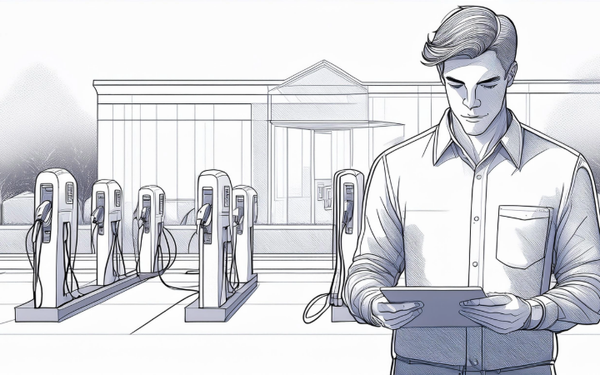13 Considerations for Charge Point Operators When Planning EV Charging Station Locations
Planning the installation of profitable EV charging stations requires a strategic approach that considers many factors. Here are 13 key considerations a Charge Point Operator (CPO) must evaluate:

Planning the installation of profitable EV charging stations requires a strategic approach that takes into account a multitude of factors. Here are the key considerations a Charge Point Operator (CPO) must evaluate:
1. Demand Analysis
- Current EV Ownership: Assess the density of electric vehicle (EV) ownership in potential areas. Higher concentrations of EVs indicate a greater demand for charging stations.
- Future Growth Projections: Analyze market trends and local policies promoting EV adoption to anticipate future demand.
2. Site Visibility and Accessibility
- High-Traffic Locations: Choose sites with high visibility and foot traffic, such as shopping centers, business districts, tourist attractions, and highway rest stops.
- Ease of Access: Ensure the location is easily accessible from major roads and highways, with clear signage directing EV drivers to the charging stations.
3. Proximity to Amenities
- Convenience for Users: Sites near amenities like restaurants, cafes, retail stores, and entertainment venues encourage users to spend time and money while their vehicle charges, enhancing the attractiveness of the location.
- Duration of Stay: Locations where users tend to stay longer, such as hotels, office buildings, and residential complexes, are ideal for installing slower chargers (Level 2). High-turnover locations like shopping centers might benefit from faster chargers (DC fast chargers).
4. Electrical Infrastructure
- Grid Capacity: Evaluate the existing electrical infrastructure's capacity to support new charging stations. Some locations may require significant upgrades to handle the additional load.
- Cost of Upgrades: Consider the costs associated with upgrading electrical infrastructure if necessary. This includes potential costs for transformer upgrades, additional wiring, and ensuring compliance with local electrical codes.
5. Real Estate and Leasing Considerations
- Site Ownership: Identify whether the site will be owned or leased. Long-term leases can provide stability but may require negotiation with property owners.
- Lease Terms: Ensure favorable lease terms, including rent, duration, and responsibilities for maintenance and utilities.
6. Regulatory and Permitting Requirements
- Local Regulations: Understand and comply with local zoning laws, building codes, and permitting requirements. Some areas may have incentives or streamlined processes for EV infrastructure.
- Environmental Impact: Assess and mitigate any environmental impacts, which might be required for obtaining necessary permits.
7. Financial Considerations
- Cost-Benefit Analysis: Conduct a thorough cost-benefit analysis considering installation costs, operational expenses, and projected revenue.
- Incentives and Grants: Leverage available federal, state, and local grants and incentives to offset initial installation costs and enhance profitability.
- Pricing Strategy: Develop a competitive pricing strategy that balances affordability for users and profitability for the operator.
8. Partnership Opportunities
- Local Businesses: Partner with local businesses that can benefit from increased foot traffic. Co-location agreements can reduce costs and enhance mutual benefits.
- Utility Companies: Collaborate with utility companies for potential cost-sharing of grid upgrades and to ensure efficient energy management.
9. Competitive Landscape
- Existing Stations: Analyze the density and utilization rates of existing charging stations in the area to avoid oversaturation and identify underserved locations.
- Service Differentiation: Offer unique features or superior service (e.g., faster charging speeds, better amenities, loyalty programs) to attract users in competitive markets.
10. Technological Considerations
- Charger Types: Decide on the types of chargers to install (Level 2, DC fast chargers) based on the anticipated user needs and location characteristics.
- Future-Proofing: Invest in scalable and upgradable infrastructure to accommodate future technological advancements and increasing demand.
11. User Experience
- Reliability: Ensure that charging stations are reliable and well-maintained to build user trust and repeat usage.
- User Interface: Provide user-friendly interfaces and seamless payment options through apps or contactless payments.
- Support Services: Offer 24/7 customer support to assist with any issues users may encounter.
12. Security and Safety
- Site Safety: Ensure the site is well-lit and secure, reducing the risk of vandalism and ensuring user safety.
- Safety Compliance: Adhere to all safety standards and regulations for installation and operation of electrical equipment.
13. Marketing and Community Engagement
- Awareness Campaigns: Launch marketing campaigns to raise awareness about the new charging stations and their locations.
- Community Involvement: Engage with local communities to build support and promote the benefits of EV adoption and charging infrastructure.
Conclusion
By carefully considering these factors, Charge Point Operators can strategically select locations that maximize profitability, meet user needs, and support the broader goal of expanding the EV charging infrastructure. The successful implementation of these considerations will help in establishing a sustainable and profitable network of charging stations, driving the transition to electric mobility.





